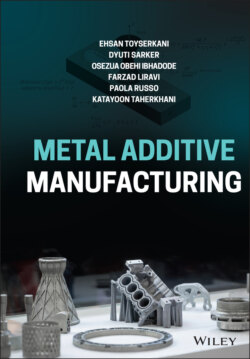Читать книгу Metal Additive Manufacturing - Ehsan Toyserkani - Страница 22
1.5.2 Aerospace and Defense
ОглавлениеThe industrial adoption of metal AM was ramped up when large aviation, aerospace, and defense organizations/agencies such as GE Aviation, Lockheed Martin, SpaceX, the U.S. Department of Defense, and U.S. Air Force joined the race and started to heavily invest in R&D, machine development, advanced materials, and government‐backed AM programs in mid 2010s. AM is uniquely attractive to this sector because of the lower material waste, lightweighting, reduction of the need for assembly through components consolidation, and the capability of production of highly intricate and complex parts that ultimately contribute to less fuel consumption and cost‐saving due to lower level of certification as the number of parts decreases [20].
Led by safety requirements, this industry is known for having rigorous testing and certification procedures to evaluate the performance of the parts. As such, further improvements in the repeatability, reliability, and control of the metal AM systems are necessary before we can see airplanes or spacecraft with the majority of their components 3D printed. Nevertheless, it is reported by GE Additive that 28 fuel nozzles, 228 stages 5 and 6 blades and, 1 heat exchanger and 16 particles separators of GE9X engine (a new generation of high‐bypass turbofan jet engine developed by GE Aviation exclusively for the Boeing 777X) are additively manufactured [7].
In space applications, the race is even wider. In 2015, the first‐ever communications satellite with a design life of 16 years and weighed 4.7 metric tons satellite (named TurkmenAlem52E) with an aluminum 3D printed component was launched by SpaceX. This component was an antenna horn mounting strut. Thales developed several antenna supports with an envelope dimension of 45 × 40 × 21 cm, made from aluminum. The AM‐made supports have saved 22% weight and a 30% cost and an estimated decrease in the production time of 1–2 months. These brackets are subjected to a wide range of thermal stresses as during normal operation, they see temperatures of −180 to +150 °C. Designing this part for 3D printing allowed a much more efficient part to be developed because fasteners were no longer needed.
On the rocket engine applications, major activities are underway by SpaceX, NASA, and Aerojet Rocketdyn to adopt AM for rocket engine components because the qualification testing and heritage could be transferrable in many situations. SpaceX launched its Falcon 9 rocket with the first time ever AM‐made Main Oxidizer Valve (MOV) in one of its nine Merlin 1D engines. The MOV operated successfully where high‐pressure liquid oxygen under cryogenic temperatures and harmonic and subharmonic vibration levels were used [21]. The printed version of this traditionally casted part actually has superior strength, ductility, and fracture resistance. The 3D printed part has lower variability in material properties vs. the cast version due to uneven cooling of the part during casting. The MOV body was printed from nickel‐based alloys using LPBF in less than 2 days versus the several months it takes to manufacture the cast version [21]. SpaceX also additively manufactured a SuperDraco Engine chamber. The SuperDraco engines are responsible for powering the Dragon Version 2 spacecraft's launch escape system. This system activates in an emergency to carry the astronauts to safety. These engines are also able to enable the spacecraft to land propulsively with the accuracy of a helicopter, making the spacecraft reusable, lowering the cost of space travel. This engine is being qualified. The qualification program includes testing multiple starts, extended firing periods, and extreme propellant flow and temperatures. Figure 1.15 shows AM‐made parts for SpaceX engines.
Currently, the propulsion system is the primary focus of Lockheed Martin's AM efforts, with a goal to reduce the lead time on the fuel tanks from 18 months to only a few weeks.
One other major activities are related to the mission to “3D Printing in Space.” While the plastic 3D printing has been tested in the international space station, there are many challenges associated with metal AM in space. The issue of “gravity” must be resolved before AM can be reliably replaced with expensive supply runs to the space stations.
Figure 1.15 LPBF‐made combustion chamber (left) and the engine in finished configuration (right).
Source: Courtesy of SpaceX [22].
Another development is associated with Boeing, where the company patented a 3D printing process that prints objects while they are floating in midair. This process uses magnets or acoustic waves to levitate the part while multiple AM systems apply the layers of material.
DED technology is also used in the aerospace and defense industry for repairing and refurbishment of the parts. It is a particularly important application given the long life cycle of aviatic systems and the high cost and long lead time associated with the replacement of the parts. As a result of a 2020 survey conducted by Optomec, one of the leading manufacturers of DED systems, from over 100 of their customers in the aviation market, it is claimed that over 10 million turbine blades have been repaired using DED systems. Repairing parts using DED has a lower thermal impact on the part in comparison with traditional methods such as welding. As a result, the parts will have a more favorable microstructure and mechanical performance after the repair using DED [23].
